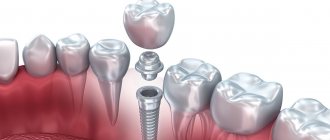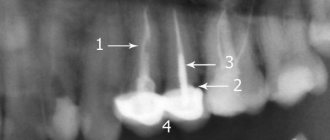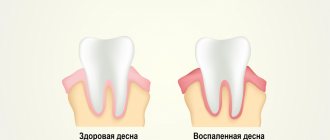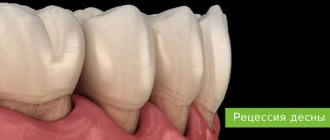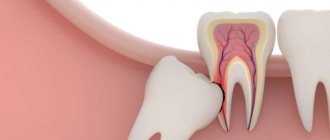A gummy smile is a physiological feature in which the upper gum is excessively exposed. With a normal smile, 1-2 mm of gum is visible; if more, then such a smile is called gingival or “gummy smile”. Such exposure of the mucous membrane is not considered a pathology, does not in any way affect diction, chewing function, or affects the health of the teeth.
However, studies claim that excessive mucosal exposure leads to decreased self-esteem and psychological changes in 25% of cases.
[1].
Symptoms of a gummy smile – is there a problem?
It is worth noting that a gummy smile in itself is not a pathology , it does not in any way affect the health of the teeth, and does not have a negative impact on the process of chewing and digestion.
But many owners of this feature, most of them women, want to get rid of it, make their face more harmonious, because with such visualization it is sometimes visible, for example, that the teeth are dentures, the color of the gums has changed to bluish, yellowish or purple, the gums are affected by periodontal disease. In this case, we are talking about smile aesthetics , which can be achieved by several types of correction.
Video: Gummy Smile. Correction methods
A person’s gummy smile is immediately noticeable - not only the upper teeth are exposed, but also most of the gums, and in some cases the demarcation line between the gum and lip is visible, as well as the place where the upper frenulum is attached to the gum.
A high smile is indicated by the degree of gum exposure. A relative norm is a smile in which the upper lip remains on the upper line of the teeth - or no more than 2 mm above it.
Reasons for the formation of a high gummy smile
In the vast majority of cases, high gums when smiling are the result of individual developmental characteristics of the maxillofacial region of a person, which are formed in utero.
There are a number of other reasons when a person develops a gummy, or “horse” smile:
- Abnormal growth of the maxillofacial apparatus in infancy and childhood under the influence of various negative factors.
- Formation of malocclusion in a child.
- Irregular growth of teeth, their severe curvature and protrusion.
- Very short and thin upper lip.
- Shortening of the upper frenulum that was not corrected in time.
- Disproportionately small incisors on the upper jaw.
- Greater mobility of the upper lip.
- Spastic conditions in this area.
Postoperative care
Usually, after surgery, the doctor gives recommendations regarding scarring of the incisions. They must be strictly followed. Besides:
- For a week, preferably a week and a half, the patient should not smile, not to mention openly laugh.
- Hard and hot foods should be avoided.
- It is worth giving up those foods that require long and hard chewing.
- After each meal, and this is several times a day, you should definitely rinse your mouth with solutions intended for sanitization. They must be prescribed by a doctor.
Patients do not stay in the hospital for a long time, because surgical procedures are performed under local anesthesia. Thanks to the laser scalpel, the procedure is almost bloodless, the incision is precise and thin. Cosmetic scars after such manipulation are not visible.
Gingivectomy is a dental or surgical method for correcting high gums.
The gingivectomy method is indicated for conditions where there is too much gum above the upper teeth. As a result, it covers a very large part of the teeth, as if hanging over them, which forms a visual gummy smile.
Types of osteomucogingival surgeries in dentistry
It must be borne in mind that the results of this method are irreversible, so surgical correction is prescribed in the most extreme cases with the above-described features, and this happens infrequently.
Video: Gingivectomy - treatment of a gummy smile
The operating method is the most difficult. It is associated with the removal of gum tissue, which invariably has all the consequences of surgical intervention - bleeding of the gums, scarring, possible infection, asymmetry. The development of laser surgery helps to minimize the above-described consequences in operative dentistry, but it is still necessary to keep them in mind, paying due attention to preventive measures.
Removing gum tissue can lead to another consequence that has aesthetic and dental significance - excessive exposure of teeth. This will visually lengthen the teeth and partially expose the roots, which will negatively affect subsequent aesthetics. Therefore, further orthodontic correction with the use of dental crowns and onlays is required.
In order to get the most successful results, the dentist will make a decision not alone, but with a council of specialists, which should include a specialist in aesthetic dentistry.
A decision is made collectively about the need for surgery, and the volume of gum tissue that will be removed without negative consequences for aesthetics is determined as accurately as possible.
Magazine "PARTNER"
“Partner” No. 6 (153) 2010
Anatoly Sigalov (Ulm)
When the famous comedian Louis de Funes died, the French press wrote that “this genius brought French comedy out of the hibernation into which politics had driven it.” This is true, but let's be honest - in French cinema even before Louis de Funes there was someone to make people laugh. When he was just starting his career, the audience had long been amused by the brilliant Fernandel, “the most subtle comedian in France.” Of course, in Europe there were films by Chaplin, Buster Keaton, Max Linder and Harry Lloyd, where crazy fun reigned, but the secrets of their comedies lay in eccentricity and stunts. Fernandel was inactive, his face made him laugh. It was enough for him to smile his inimitable “horse” smile or roll his eyes to the sky, as the audience began to laugh, realizing what an absurd situation his hero had found himself in. And then, Fernandel was a Frenchman, a “national treasure of France,” like Bourville and Louis de Funès later. Comedies with Fernandel's participation made the whole of Europe laugh. At the same time, Fernandel was an excellent dramatic actor, and his last role in the film “The Devil and the Ten Commandments” (1963) was played simply brilliantly. Fernandel lived only 68 years (born May 8, 1903 - died February 26, 1971). Not enough for a person, not enough for an artist! There were plenty of paradoxes in Fernandel's life. For example, in his youth he became a bank employee, afraid of his calling: to make people laugh. A calling that he discovered within himself as a child. For the first time he made his father laugh, then all his relatives, then his teachers, classmates and friends. The last important person whom Fernandel made fun of in his pre-acting past was the director of the bank where he served. The sleeve where the cigarette, which was prohibited in the workplace, was hidden began to smoke. A boss passing by saw this. He immediately called Fernandel into the office and said goodbye to him. At the same time, looking at the sad face of the employee, he concluded: “Ha-ha-ha... sorry... ha-ha... you’re fired,” and added after, “a clown.” Then his name was simply Fernand Joseph Contandin. Subsequently, Fernandel said that he was grateful to that director - he determined his fate. From that moment he finally decided to become a comedian. Fernand began playing and singing as a child, and his theatrical debut took place at the age of five on the stage of the old Marseille theater "Chave", located not far from the house where the Contandens lived. Then, having put together a cheerful duet “Fernand and Marcel” with his brother, he successfully performed on the stage of a local cabaret. Three years later, the Parisian newspaper “Comédie” announced a competition for amateur chansonniers. Paris is a career, and there were qualifying rounds all over France. There were more than a hundred applicants, Fernand was second. He was then twelve years old. Now all of Marseille knew the funny “little Blue”. “I knew,” Fernandel recalled, “that fame is gained in Paris, but popularity is gained in Marseille, and popularity is fame without a jacket, with rolled up sleeves.” And then the war began, and Fernand had to earn a living in different professions: docker, grocer, bank clerk... he hated them and stubbornly sang in cabarets in the evenings. He was only nineteen when he signed his first professional artistic contract (one hundred francs a day!) with the Eldorado cabaret in Nice. It was then that Fernand Joseph Contandin became Fernandel. And I realized what real acting is. Fernandel worked a lot, played in operettas, sang in the music hall, and his fame grew in proportion to his experience and skill. He made a successful film debut, starring in the comedy “The Best Nanny” in 1930, receiving excellent press and public reviews. “French comedy shone with Fernandel’s “horse” smile!” - the newspapers broadcast, competing in wit. And offers poured in for Fernandel. At the same time, he arranged his personal life: he fell in love with Henrieta, the sister of his friend, screenwriter Jean Manse, easily married her and a couple of years later became the father of little Jose, whom he loved as passionately as his wife. In a word, the artist’s popularity grew, he was happy in his family, and nothing could stop him from pursuing his career, not even the army, where he was drafted twice. Thanks to his fame and connections, the service turned out to be “an easy walk for him, during which he did not even learn to shoot.” Fernandel was talented, but pragmatic - he entered only those doors from which he emerged victorious. During his first service, he achieved a transfer to Marseille, spent the night not in the barracks, but at home, on Jaurès Boulevard, continued performing on stage and took long vacations to film films. But after the service, having quarreled with the director of the music hall, Fernandel found himself... at a soap factory as a worker. He knew that this was necessary, believing in a happy turn of fate that would not allow him to “end his life in soap.” And the “turn” took place. The director of the famous Paramount Theater, who happened to be in Marseille, offered the artist a contract for a tour in France and abroad. In the troupe, Fernandel immediately became a star, his performances attracted full houses. And two months later, upon returning from the tour, a letter was waiting for him - the famous Parisian Bobino theater opened its curtain for him. This is what Fernandel wanted! Now he lives in the “Mecca of the Arts” - Paris, and successfully performs on the Parisian stage. And then offers from famous film directors follow one after another. Before the war, Fernandel played about thirty film roles, but the most significant ones, which brought him great popularity, were roles in the films of Marc Allegre, Jean Soreno and Christian-Jacques - “White and Black” (1931), “His Concierge’s Lover” (1934), “ The Straw Hat" (1940), and the film "The Ballroom Notebook" even received a prize at the Venice Film Festival in 1937. In these films, as in many others, Fernandel’s comedic and acting talent was fully revealed. And if we have already touched on the chronicle, we will add that the post-war comedies are the diamonds of French cinema with the participation of Fernandel, which we know and which are often shown on TV: “Casimir” (1951), “The Law is the Law” (1957), “The Devil and Ten Commandments" (1963), brought the actor universal European recognition. However, there were not so many such successes in Fernandel’s film career, but this is not surprising - after all, the comedian starred in only one hundred and fifty films! And he was not judged strictly even when the master, having faith in his talent, acted unsuccessfully as a director, making three films that completely failed at the box office. Fernandel no longer engaged in reckless experiments, but acted as an artist, successfully leading his acting and public career, and at the same time French cinema, to Olympus. In 1951, Fernandel starred in the film “The Small World of Don Camillo” directed by Julien Duvivier, which marked the beginning of a whole series of films about the funny and sad rural pastor Don Camillo, which lasted for nineteen years. In the fifties and sixties of the last century, Fernandel was at the zenith of fame, in the center of attention of the press and the love of fans. He receives the rosette of the Legion of Honor and the Medal of Civil Merit. He makes a creative tour of Europe, South America, the United States and Canada, where he receives the ironic nickname “The First After French Culture.” He was received by the Pope and more than once won the Courtelain Prize, the highest award for a French comedian. Fernandel's voice, reading radio broadcasts and literary works, can be heard in all schools in France. He becomes one of the richest French actors, which was also part of his plans. But for some reason the artist himself smiled less and less from year to year, and his characters became sadder. Why? Maybe it’s age, or maybe it’s the dissatisfaction that arises among artists when they look back on the path they’ve traveled? In 1963, Fernandel, together with Jean Gabin, created his own studio “Gafer” and plunged headlong into production work. Nothing significant appears on the screen, only remakes of his old films. Time passed, new comedians came to the cinema - Bourville, Louis de Funes, and viewers began to forget Fernandel’s “golden horse smile”... The wise and pragmatic Fernandel foresaw this and in the late sixties decided to star in “ten more films” and retire, in oblivion... But the master did not calculate everything. On February 26, 1971, the famous French comedian Fernandel passed away.
| No. 6 (153) 2010 | Read: 2085
| Author: Sigalov A. |
Correction of a high smile using a cosmetic method using Botox
In case of hypermobility of the upper lip, excessive facial expressions of the patient, when they cause the visualization of the gums when smiling and talking, there is an excellent method for correcting the condition - Botox injections, which relax the active muscles of this area and help reduce their mobility.
Treatment is achieved by administering bolutoxin type A (Botox and Dysport, popular drugs in cosmetology).
Video: Correction of a gummy smile with Botox
Women who receive Botox injections in cosmetology clinics to reduce wrinkles on the face and enlarge lips also note correction of a gummy smile, if present.
This method, unlike the surgical one, is reversible - this is both a minus and a plus at the same time. Up to six months, the effect of the injections wears off, and so does all the correction he achieved. The procedure must be repeated if desired.
It is very important to entrust the injection Botox correction of a gummy smile to an aesthetic dentistry clinic, a specialist with extensive experience and relevant medical knowledge.
Attention! The consequences of incorrect administration of Botox can be asymmetry of the face and lips, with an incorrectly calculated dose - lack of results, or vice versa - a strong degree of immobilization of the perioral area.
Muscle suturing
Another method used to remove a gummy smile is to perform a small operation under local anesthesia. After the anesthesia takes effect, the doctor makes an incision under the upper lip, through which the orbicularis oris muscle is sutured, depriving it of hypermobility, as well as the mucous membrane. This procedure is more serious, but quite effective.
Speech therapy correction of a gummy smile
The method is indicated for insignificant visualization of the gums, or for excessive facial expressions of the patient, hypermobility of the lips.
The correction process is carried out with a speech therapist who teaches a person to correctly pronounce sounds and words, control his speech apparatus while talking or smiling.
Excellent results are achieved by performing certain exercises regularly. In the future, the person simply automatically controls the movement of his lips, stopping the upper lip in the correct position, which allows him to achieve an excellent aesthetic effect without any intervention in the tissue.
The method of speech therapy correction perfectly complements other methods from our list. It is suitable for most people who want to correct a high type of smile.
Keep in mind! But without constant self-control and regular exercise, you may not get results.
Surgical correction of the upper lip and upper frenulum
The surgical method consists of excision of a section of the mucous membrane on the inner surface of the upper lip and further attachment of the muscle fibers of the lip slightly lower than their original state.
If the cause of excessive visualization of the gums - and errors in eating and speaking - is a greatly shortened upper frenulum, which forms a dense cord and does not allow the upper lip to be lowered to the desired level, it is corrected.
As a rule, such an operation on the frenulum is performed in childhood.
After the surgical field has healed, the desired visual effect is achieved.
Orthodontic correction of high smile and dental problems
If a gummy type of smile is the result of improper formation of the dentition, deformation of not only the teeth, but also the bone tissue of the jaws, the help of an orthodontist is required.
This method may include several types of orthodontic correction, depending on the type and degree of pathology, the age of the patient, and the presence of other pathological conditions.
Most often, orthodontic correction consists of straightening the teeth through long-term wearing of braces.
In most cases, this correction method is used in combination with others - for example, surgical or cosmetic.
Maxillofacial Surgery
Some very serious problems cannot be solved except in the operating room. Anomalies in the development of the jaw due to improper breathing and nutrition in infancy can result in adult problems not only of an aesthetic, but also of a medical nature. Fortunately, modern surgery can do almost everything - doctors can shorten the upper jaw, raising the teeth to their correct place. True, such a procedure not only requires longer rehabilitation, but will most likely cost a pretty penny.
